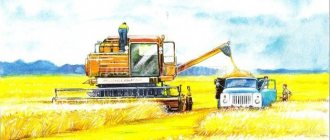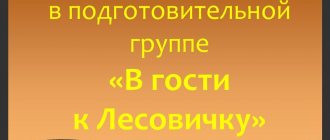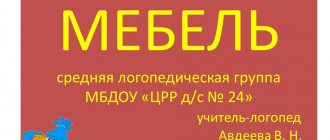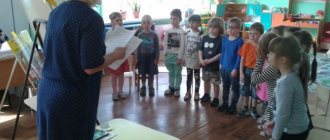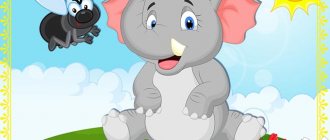Summary of the lesson “Heroes of the Russian Land” in literature
with older children
to form a holistic picture of the world
Topic: “Bogatyrs of the Russian Land”
Formation of ideas about the heroic past of the Russian people of Ancient Rus', the great Russian heroes - defenders of the Russian land. Tasks:
1. Revive the idea of the epic, about the epic heroes - Ilya Muromets, Alyosha Popovich, Dobrynya Nikitich. 2. Arouse interest in the language of epics, tales, songs, legends about Russian heroes. 3. Introduce children to the weapons of heroes. 4. Foster a sense of pride in the heroic strength of Russia, respect for Russian soldiers, and a desire to imitate them.
Development of conceptual vocabulary
:
Bogatyr, guslar, chain mail, armor, equipment, Slavs, Russians, marshy swamps, epics, sword, mace, club, flail, spear, axe, chasing, axe, battle scourge, chain, bow and arrows, knives , dagger, harp.
Preliminary work:
Examination of the painting “Bogatyrs” by Viktor Mikhailovich Vasnetsov.
Examination of the panel “Russian heroes” with artistic material about epic heroes. Reading passages about epic heroes: “Ilya Muromets and the Tin Robber”, “Dobrynya Nikitich and the Serpent Gorynych”, “Alyosha Popovich and Tugarin the Serpent”. Listening to the recording of the epics “Ilya Muromets and the Nightingale the Robber”, “Finist-Clear Falcon”, “Nikita Kozhemyaka”, “The Serpent Gorynych”, “The Tale of the Dead Princess and the Seven Knights”, “The Tale of Tsar Saltan”. Drawing up a family tree (drawn). Art activities on the topics: “Weapons of heroes”, “Bogatyrs”, “Horses of Russian heroes”. Equipment:
Illustrations of heroes of Ancient Russia; cards depicting the weapons of heroes (sword, mace, flail, etc.) and the weapons of modern warriors (pistol, shotgun, rifle, machine gun); costumes of heroes and guslar, ropes, a river, pebbles made of paper, a stone at a crossroads, three roads, a forest, images of Kashchei the Immortal, Nightingale the Robber, Snake Gorynych.
Progress of the lesson:
Educator:
A long time ago, in the place of the cities and villages where we now live, there were impenetrable forests full of animals and birds.
Many territories were occupied by marshy swamps. Since ancient times, Slavs lived on this land. Their neighbors, the Khazars and Mongols - the Tatars - often attacked the Slavs, devastated lands, destroyed houses, and took people captive. More than 1000 years ago, the Slavs founded their state, called Russia. Rus' defended itself from enemies. Only very strong, hardy and brave people could live in such conditions. Such people were called Russians. They were famous for their heroic strength; fairy tales and epics were written about their exploits. Heroes lived among the Russians - the defenders of our Motherland in ancient times. This is what they looked like. (Shows illustrations of heroes and the painting by V. M. Vasnetsov “Bogatyrs”). Look, guys, how powerful, courageous, brave and strong they were. Who is shown in the picture? Children:
Ilya Muromets, Dobrynya Nikitich, Alyosha Popovich.
Educator:
That's right, who were they?
Children:
Bogatyrs.
Educator: Children, who do you think the heroes are? Children:
Bogatyrs are people who defended our Motherland from enemies.
Educator:
That's right, heroes are people of immeasurable strength, stamina and courage who perform military feats.
The heroes protected our Motherland from enemies - they stood at the outpost (border), no animal would slip past them unnoticed, no bird would fly by, much less an enemy would pass by. Guys, we have already read a lot of fairy tales and epics about the heroes of the Russian land. Let's remember what they are called? Children:
“Nightingale the Robber”, “Finist-Yasny Falcon”, “Nikita Kozhemyaka”, “Serpent Gorynych”, “Alyosha Popovich and Tugarin the Serpent”, etc.
Educator:
Children, who did the heroes - the heroes - fight with?
Children:
With Nightingale the Robber, Gorynych the Serpent, Koshchei the Immortal, Tugarin the Serpent.
Educator:
Children, would you like to follow the path of heroes, see them, learn about their exploits?
Children:
Yes.
Educator:
Then we need to get ready for a difficult, dangerous journey, where unusual adventures will await us, won’t you be scared?
I know that you are friendly and brave. Friendship will help us overcome all obstacles. But first, let's remember, before setting off on a long journey, what did the Russian hero have to choose? Children:
Way to go.
Educator:
That's right, he had to choose the path to take.
In fairy tales and epics, the hero always stood at a crossroads near a stone on which it was written where to go. Here on our road there is such a stone, on it it is written: “If you go to the right, Money and fame, If you go to the left, you will lose friends and you will not be brave.” You will move straight. Danger and a heroic outpost await. “So, guys, which road are you and I choosing? Children:
The road that goes straight.
A teacher and children are walking along the road and in front of them is the first obstacle. (The tape recorder starts and a fabulous voice says the first task). Voice:
(Task 1) First, warm up, walk along the rope, you can’t step off it. Friends are waiting for you there.
(There is a rope laid out on the floor, which children need to walk along with their eyes closed, hands on their belts). Voice:
(task 2) This is an obstacle on the way. It can’t be passed so easily. We must quickly remember and say proverbs!
(We need to say proverbs about courage, bravery and the Motherland of Russian heroes). Proverbs and sayings about courage, courage, the Motherland.
Courage is the strength of the commander.
The hero who fights hard for his homeland. Whoever dared sat on a horse. Stand by your edge to the death. The Russian does not joke with the ball or the roll. Die yourself, but help your comrade. Die from your native land, don’t leave. To live is to serve the Motherland. Happiness of the Motherland is more valuable than life. Not the hero who expects a reward, but the hero who goes for the people. If friendship is great, the Motherland will be strong. Voice:
(task 3) There’s a river on the way. You can’t pass, you can’t pass. The Nightingale is an evil robber. The bridge was broken here over the river.
(You need to cross the river on pebbles, shifting them). Voice:
(task 4) Here is an obstacle, here is Kashchei. He eats many, many children (cabbage soup). In order for you to go further, you need to prove that you are heroes.
Lesson summary on art “Russian heroes”. Project task “Bogatyrs of the Russian Land.”
Teacher: But what does our stone show?
shows: if you go straight, you will end up in an art studio, if you go to the left, you will end up in a music room, if you go right, you will end up in an art gallery.
Which arrow is blinking and where is it pointing? (Art Gallery). What do you think we can see in the art gallery?
And what kind of paintings will we look at today?
Slide 3 (Painting by Vasnetsov V. “Three Heroes”)
This is one of the best paintings of Russian painting. Viktor Mikhailovich Vasnetsov wrote it for 27 years. In order to write it, the artist studied many epics and legends, listened to the works of musicians, and wrote many sketches.
Who is depicted in the painting by Viktor Mikhailovich Vasnetsov?
Teacher: What do heroes do in an open field?
What are the names of the heroes?
What words can describe each hero?
Which of the heroes is depicted in the center of the picture?
Why did you decide so?
Alyosha Grigoriev prepared for us a short story about Ilya Muromets.
What else do you know about the hero?
In the center of the picture, on a black horse, sits Ilya Muromets, the peasant son, a glorious hero. The eldest of the heroes. There is a sense of strength in his appearance. He has a stern face and a gray beard. Ilya Muromets is dressed in iron chain mail and has a helmet on his head. The hero is armed with a club, a spear and a sword. The hero peers vigilantly into the distance.
Who is depicted on the right hand of Ilya Muromets?
Let's listen to Kolya Shcherbakov's story about this hero.
Describe how he is dressed, what is his face like? Why is he dressed richly?
Dobrynya Nikitich is dexterous and brave. He has brown hair and a beard. Dressed richly and elegantly. Because he has a red shield and a white horse. He is already taking out a sharp sword from its sheath, as if he is about to rush into battle.
Who did Dobrynyushka defeat?
Teacher: And who is on the left hand of Dobrynyushka?
What family was Alyosha born into?
What is he famous for?
How did Alyosha defeat his enemies?
Alyosha Popovich is brave and courageous, but not as strong as Ilya Muromets and Dobrynya Nikitich... And his horse looks in the other direction, but notices everything. A harp and a bow and arrows are attached to the horse.
And I also want to add. Draw your attention to the landscape. The heroes are surrounded by the steppe, hills behind them, and lead clouds all around. And above the heroes there are bright clouds.
Why do you think the artist depicted it this way?
Think about how this picture makes us feel?
An ancient legend, through the mouth of one of the conquerors, warns: “I also tell my children and grandchildren not to go to war against Great Rus', it has stood for centuries without shaking and will stand for centuries without moving.” Where do Russian warriors get their inexhaustible strength from? They say that they inherited it from distant ancestors, about whom songs and legends were composed - from epic heroes. From time immemorial there were people whom the people loved, whose names they kept in their hearts. These are those who defended the poor, who protected the Russian land, who did not give offense to the weak.
"Bogatyrs of the Russian land..."
Name of the project task
Bogatyrs of the Russian land...
Integrated (fine arts, history)
Goals and pedagogical objectives (pedagogical intent)
Create conditions for organizing interaction (cooperation) between children when solving a project problem, to create a wall newspaper “Heroes of the Russian Land...”.
Knowledge, skills and methods of action on which the task is based
ability to work with text, extract the necessary information in explicit and implicit form.
learn to build a poster composition using means of expression
gaining experience working with various art materials in the process of creating a creative product;
develop a willingness to openly express and defend one’s position;
be able to collaborate in joint problem solving
analyze, draw conclusions;
discuss and analyze the work of classmates from the perspective of creative tasks.
"Bogatyrs of the Russian Land." Summary of a drawing lesson in the preparatory group
Elena Portnykh
"Bogatyrs of the Russian Land." Summary of a drawing lesson in the preparatory group
To form an idea of the heroic defenders of the Russian land.
Tasks:
Continue getting acquainted with one of the types of fine art (portrait).
Develop the ability to convey human proportions, character traits, and mood. Develop logical thinking, creative imagination, aesthetic feelings.
To foster a sense of pride in the heroes, heroes of the Russian land.
Preliminary work:
Conversation on the painting by V. M. Vasnetsov “Bogatyrs”.
Listening to the recording of the epic “Ilya Muromets and the Nightingale the Robber”, the song “Heroic Power” by A. N. Pakhmutova.
Reading excerpts from epic tales about heroes.
Watching cartoons: “Alyosha Popovich and Tugarin the Serpent”, “Three Heroes and the Shamakhan Queen”, “Ivan Tsarevich and the Gray Wolf”, “Ilya Muromets and the Nightingale the Robber”, “Dobrynya Nikitich and the Serpent Gorynych”.
Materials for the lesson:
Interactive board, image of V. Vasnetsov’s painting “Three Heroes”, coloring pages of heroes previously made by children based on modern cartoons, white paper, pencils, colored pencils, wax crayons.

